Saturday, April 30, 2016
Run on a Ticket With Donald Trump? No, Thanks, Many Republicans Say
Bin Laden's bodyguards were fed up, documents show
USS Stennis denied entry to Hong Kong port
Protesters delay Trump speech
Friday, April 29, 2016
At Small Colleges, Harsh Lessons About Cash Flow
US accuses Russia over jet manoeuvre
70-year-old Puerto Rican man dies from complications of virus
USS Stennis denied entry to Hong Kong port
Thursday, April 28, 2016
Colorado Weighs Replacing Obama's Health Policy With Universal Coverage
Arrests linked to San Bernardino gunman
As North Korea flexes its muscle, what can U.S. do?
Wednesday, April 27, 2016
Facebook revenue smashes expectations as mobile ad sales surge
Case Study: How One Trick Can Help You Gain 200+ Links from Badass Sites
This is a guest contribution from Emily Johnson.
Do you consider all specifics of your content and audience when it comes to promotion?
The thing is, entertaining content and useful content are far from the same.
When your niche is popular and loved by millions, you have no problems with content creation and distribution. But what can you do to deal with a not so well-loved niche promotion? How can you build more links to it from A-list blogs with fewer efforts?
The trick is, create content which will be useful for the audience that is much broader than yours.
Let me explain
Useful content is one aimed at solving a problem of your target audience. The more vital the problem and the better solution you have for it, the better result you'll get from the promotion.
Yes, you know it already. But:
Aiming to promote a small website on unpopular or controversial fields, you face many challenges at once, including a niche and audience specifics. This case study reveals the details of working with such websites and shares the secrets of distributing their content, gaining links from top blogs, such as HuffPost, Inc., and others.
What we had:
- a narrow niche, which most Internet users consider controversial
- strict time frames
- small funds.
What we needed:
- a content idea that would make a buzz
- compelling content to promote
- links from A-list resources.
And the results we've got:
- 192 linking root domains acquired
- 71 linking domains on sites with Moz DA of 50+
- the mentions from such Goliaths of the Internet as HuffPost, Inc., About.com, Adweek, LifeHack, and others.
As you see, impossible is nothing. And you can do the same, or even better.
How?
This case study explains.
The Idea
First of all, think about a content idea that will be both relevant to your website and able to attract a broader audience.
Things to consider:
1) Niche. Make sure the content will complement it. (Our case was a writing niche, so we concentrated on writers.)
2) Audience. Try embracing everyone involved with the niche, too. (Our case was the issue of creating a writer-minded post that would be useful for others as well.)
3) Popular content. Search the Web to determine the most liked and shared publications on the topic to understand what content your audience will like. (We used BuzzSumo to find the most shared content on writing, What's Trending to find the latest writing trends, and Open Site Explorer to examine our competitors' content and see what websites linked to it.)
And now, brainstorming begins!
Tip: Don't limit yourself to anything during brainstorming. Collect and write down even the craziest ideas that come to your mind and seem irrelevant first. Always think of alternative categories of users to attract with your information, and take them into account when choosing the final concept of your content.
It can be challenging, but… the sky's the limit.
By reference to your research, outline several topics and then choose the one always in-demand.
Our case was the issue of workplace organization. Chosen from five writer-minded topics, initially outlined by our team, it provided the data interesting for bloggers, IT managers, internet marketers, freelancers, and all office employees in general. No matter where they worked, office or home, each of them could use the content for productivity boost and organization of their workspace.
Bonus tip: Think big! If your website is about writing, it doesn't mean you can generate content for writers only. Our case is an example of content combining such topics as writing, work, career, freelancing, productivity, and health. But it's still relevant.
The Process of Creation
With a great idea in pocket, consider the following:
1) Content format. Learn what attracts your audience most. (Our case is an infographic with a text to make the content visually attractive.)
2) Small details. Pay attention to them, as they make readers admire and want to share your work. (Our case was details in the infographic such as covers of best-selling books on shelves or a homepage of a world-famous writing project at comp screen.)

3) Performers, aka people who will create content. (Our case was to find a professional designer for the infographic.)
And here the problem comes:
With strained circumstances, you can't pay big money to writers and designers. But you still need beautiful content of a high quality.
Tip: Don't ignore international specialists, as they'll often give you the same quality for a lower price. Use Behance to find them. (Our case was a pro designer from Ukraine who created a great infographic for $250 while US designers asked $1,000 for the same work.)
Bonus tip: You can use saved money for paid channels of getting traffic.
Outreach and Promotion
Brian Dean's Skyscraper Technique would be a good framework here. However, you may want to change it a bit, considering the scope of the method and the specifics of your promoted content.
So, how it works when you decide to get links from…
Websites and blogs
First of all, search the Internet and find online publications that either cover your topic or might be interested in sharing your content. MOZ metrics are still significant to consider while choosing trustful donors, so we used MozBar to select the websites with DA of 30+ and structure them for further work.
Like this, for instance:

With the contact list ready, start writing emails to webmasters and making agreements about publishing.
Brian Dean advises to use a so-called Pre-Outreach tactic, but our case was to ignore it due to a lack of time. Instead, we tried to intrigue blog hosts with facts and research to make them click the link and take a look at the content:
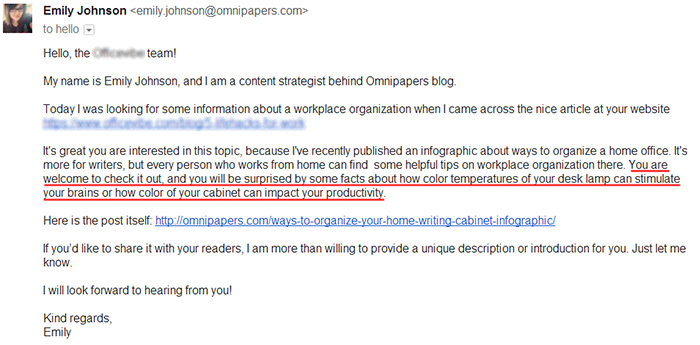
So, if you have strict time frames or just want to shorten your outreach time, try the same technique.
Replies will be not long in coming:


Tip: Try Alltop to find websites, blogs, and publications that could become your linking donors. Choose a topic, check the best and latest trends, and select webmasters to contact and offer your content.
To find latest trends, content, and influencers, you can also try Social Mention or Epic Beat.
Bonus tip: Use Email Hunter to find emails of blog hosts, editors, or webmasters to contact. It's always better to send your outreach to adam@domain.com, not info@domain.com, isn't it? If you aim to contact a news portal, not a personal blog, then look for an email of its Editor in Chief or editorial team.
Social networks
Don't forget about those sharing your content on social media: monitor users who retweet it and offer to share it at their blogs, too.
The fact people liked your content is a signal of their interest, so they might want to post something like this at their blogs as well.
That's how it works:
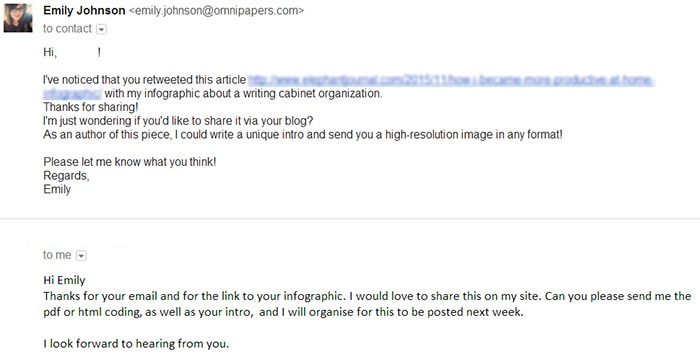
Pinterest can help you, too. Find pinboards with a type of content like yours and contact their authors, asking to pin it.
Our case was the infographic, and it worked like this:
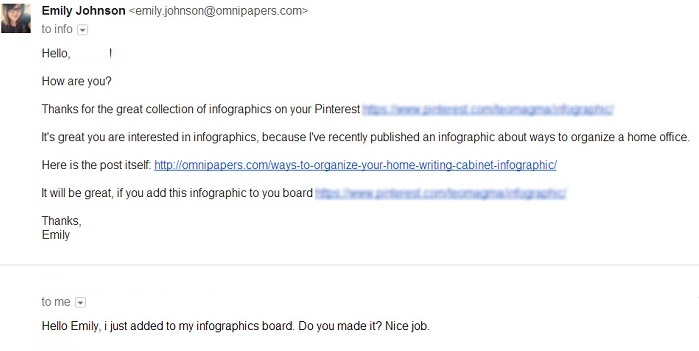
Tip: Webmasters don't have time to repurpose your content, making it original for their blogs. Don't hesitate to say you'll do that for them if needed.
c) …bloggers with columns
When your content gathered a good deal of shares, it's time to get links from A-list blogs, such as LifeHack, HuffPost, Inc., About.com, Adweek, and others.
To do that, contact bloggers who write columns at these publications.
Your step-by-step tactics to do that:
Look for authors who could be interested in your content.
Examine their writing style. How often do they publish their works? Do they have articles on your topic?
Write your first letter, describing your content idea and asking if they would like to have a look at it. Don't send any links and don't ask for sharing at once! Otherwise, huge chances are that you won't get any replies at all.
When you get a positive reply from the blogger, send your second letter with the link.
Don't send the same outreach letters to all bloggers. They are busy people, so you need different strokes for different folks.
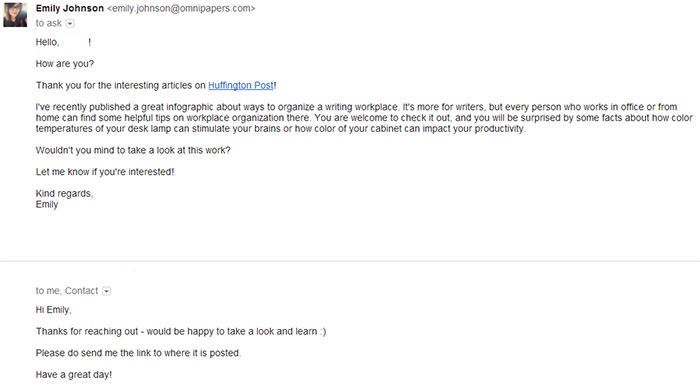
Do they like your content?
Then it's time to suggest them to share it with readers.
It's the way you can get the link from HuffingtonPost (like we did):

And Inc.:

Pitfall: Even if a blogger with the column at a badass website agrees to mention you in the post, there are no guarantees moderators will approve it. Plus, they can delete your link from the post. It's the reason why only a few agree to do that.
But it's not the reason to give up. As experience confirms, impossible is nothing.
Tip: Only 15-20% of outreach letters get replies. To understand whether receivers open and read your emails at all, use the instruments for working with inboxes, such as MailTrack or Yesware. They will let you see if and when a receiver opened your letter, or if he clicked the link in it. If your email stays unread for a week, big chances are it went to spam. Don't hesitate to send a reminder: 50% of them gets replies, as a rule.
Bonus tip: The best days to send emails are Tuesday, Wednesday, and Thursday. Monday is a day of full inboxes after weekends: your email can get lost there. Friday is when people relax before a weekend: they can decide to check it on Monday and forget about it.
Final Thoughts
You might read many case studies from big fish who could spend big money on content research and creation. Their advice is sage and practical, but would it work for you if your website is new, small, or not a brand so far?
Impossible is nothing.
Everything you need is Richard Branson's principle of “Screw It, Let's Do It!”
The moral is, the combination of useful content and reasonable outreach do wonders and bring incredible results even for tiny websites. Like ours.
Emily Johnson is a writing strategist at Omnipapers. You can chat with her on Twitter.
The post Case Study: How One Trick Can Help You Gain 200+ Links from Badass Sites appeared first on ProBlogger.
Prescription painkillers found on Prince's body, official says
Tuesday, April 26, 2016
Apple's nine-year iPhone juggernaut stops with first sales decline
After Missteps, U.S. Tightens Rules for Espionage Cases
5 “Research-Backed” Ways to Earn More Social Traction for Your Blog
 This is a guest contribution from Ashlea Green.
This is a guest contribution from Ashlea Green.
Whether you're a professional blogger or just getting started, gaining social traction for your posts is one of the most crucial tactics for getting your blog noticed and read. Hence the coined expression “content is fire, and social media is gasoline.”
The majority of bloggers are familiar with general social media strategies like (what types of content to share or where to post them), but they might not have considered implementing social tactics that are specific to their industry or “vertical”.
To help you get started, BuzzStream and Fractl collaborated on an analysis of data from 220 websites across 11 major verticals that actively produce content.
We found there are five main components to consider for your blog analysis:
- Publishers + High-Profile Bloggers
- Keywords
- Platforms
- Social Influencers + Amplifiers
- Timing
1. Reach out to publishers or other blogs that earn the most traction for their content
Guest blogging or blogger outreach can increase your blog's exposure. When you connect and build relationships with publishers and other high-profile bloggers in your industry, you are given platforms for engaging with your potential customers.
Start by considering which publishers and high-profile bloggers are worth pursuing. If a publisher has high-engagement metrics (more than 20K average shares per post), this means it will have a large audience and high share potential. However, keep in mind, popular publishers get pitched hundreds of times a day. This can make breaking through the competition a lot more difficult, especially if your idea isn't exactly new.
Low-engagement publishers could have less engagement, but their audience may be more targeted to your niche. Still, the publisher's social-sharing numbers will likely be lower as well.
Revisit this checklist when determining the reach and audience of publishers as well as their value to your strategy:
- Have they covered topics related to your blog's content?
- How many shares has their content earned on each social network?
- What number of shares do they earn on average per piece of content?
- Do the shares they've earned include keywords related to your blog's vertical?
- What is the site's domain authority? Is it high enough to benefit your SEO efforts?
A vertical-specific blog strategy will earn more shares.
To show you what your outreach strategy for social traction might look like, we've included a complimentary flipbook. It focuses on targeting outreach for the following nine verticals: Automotive, Business, Education, Entertainment, Finance, Food, Health, News, and Travel.
By downloading these free infographics, you'll also gain access to findings in the Lifestyle and Tech verticals.
From the most popular times to publish content to the least popular authors to connect with, you'll discover five main variables that can make or break the potential social traction of your content.
2. Keywords are key to reaching your blog's target audience.
Regardless of whether or not your goals include outreach, making sure your blog's keywords align with your audience should be a top priority.
In the Lifestyle vertical, the word “advice” was, on average, the fourth most-shared term from low-engagement publishers in our study, but this social traction occurred predominantly on Facebook and not Twitter, Pinterest, LinkedIn, or other social networks.
If your Lifestyle blog content is geared toward beauty or DIY projects, it's important to zone in on keyword trends in this vertical that are likely to be more effective than broader keywords. For instance, instead of using the keyword “beauty” which is a broad term, consider keywords like “beauty accessories,” or “beauty tips.” Google AdWords Keyword Planner, Keyword Tool, and Woodtracker are just a handful of free keyword tools available to you for research.
Headlines are a great place to start with your keyword strategy. Don't forget to include some positive adjectives in the title such as awesome, mind-blowing, and impressive (to name a few).
3. Understand what social platforms work best for your blog's vertical.
Facebook is the clear winner when it comes to the potential for social shares, earning 340% more weekly shares than its fellow social networks (the Food vertical was the only exception, with 51% of content coming from publications shared on Pinterest). Our research found that secondary platforms can earn upward of 30% of all social shares. So while Facebook is king, you shouldn't write off other social networks. Consider the following verticals and their engagement on various social networks:
- Business Blogs: 21% of shares for high-engagement publications were earned through LinkedIn. It's worthwhile to consider sharing your Business content on LinkedIn or publishing posts directly to this platform.
- Food, Health, Lifestyle, and Education Blogs: Pinterest ranked second for a mix of high- and low-engagement publishers in these verticals.
- Tech, Finance, and Entertainment Blogs: Twitter earned 11% of shares for high-engagement tech publishers, and 20 to 34% of shares for low-engagement finance, tech, and entertainment publications.
Take time to research the social channels and platforms that earn the most social traction for the publishers and blogs you may be reaching out to. This will give you a better idea of the shareworthy content types that you should be posting on your blog.
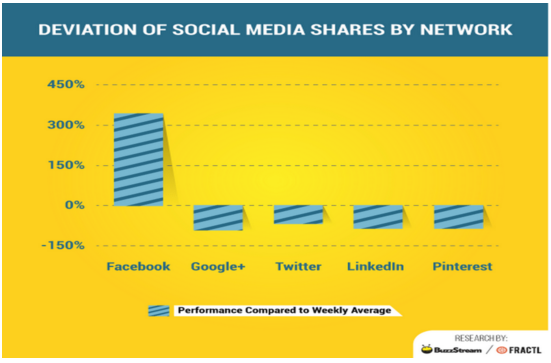
4. Determine the social influencers who will give your blog a boost.
Similar to blogger outreach, where you're connecting with top-tier publishers that earn the most engagement in your vertical, finding the best social influencers in your industry can also give your blog a boost. But keep in mind that your network's structure matters more than its size.
Twitter and LinkedIn are great places to start when looking for influencers. BuzzSumo is also a productive tool for analyzing buzzworthy content and finding influencers in your network.
Once you've narrowed down your search for your industry or niche, look out for the influencers who are followed by other influencers. Pay attention to their numbers of followers and whether their niche overlaps with other niches (such as a wedding blogger who is followed by photographers and party-planning professionals in a range of industries as well as brides-to-be). Niche influencers might have a low number of followers, but if their followers also have a narrow focus, you'll have a better chance of connecting with your target audience.
Once you've taken the time to build relationships with these influencers, try coordinating with a handful of them to push your blog content around at the same time. This will give targeted networks the impression that “everyone” is talking about your blog.
5. Timing is everything.
Whether you are about to submit your blog post or share it on social media, think twice before hitting “publish.” Turns out, 38% of all social shares occur on Tuesdays and Wednesdays. This means your content has a better chance of being seen, shared, and possibly going viral if it's published mid-week (except for the Food vertical, which had the most shares on Mondays).
But don't forget, publishers and high-profile bloggers rarely publish new content on the weekends. For this reason, avoid reaching out to publishers or publishing new content to your blog on Saturdays or Sundays (if possible).
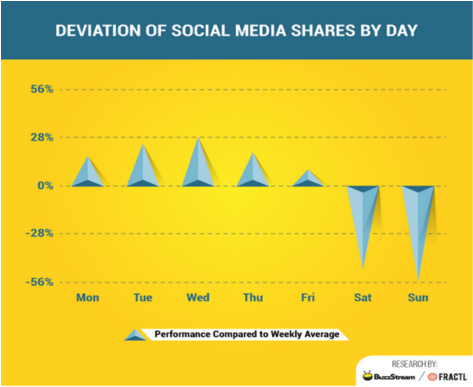
What successful strategies have you used to gain social traction for your blog? Do you have any ProBlogger secrets to share? I'd love to hear from you in the comments below.
Ashlea Green is a Strategic Growth Specialist at Fractl, a boutique creative agency specializing in high-quality content creation and placement. A coffee addict by day, book junkie by night; when she's not writing, you can find her binge-watching Harry Potter films or spoiling her little rescue dog Shorty, absolutely rotten. Chat with her: Twitter, LinkedIn, B
The post 5 “Research-Backed” Ways to Earn More Social Traction for Your Blog appeared first on ProBlogger.






